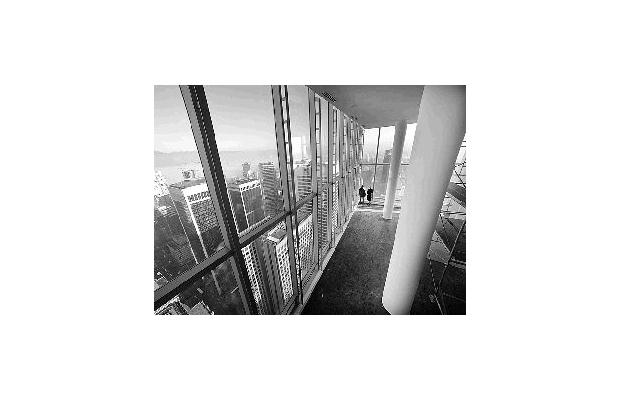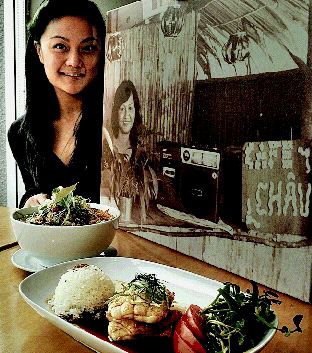A view from the top
John Mackie
Sun

Tour of the Shangri-La hotel and condominium complex offers a high-level view of a foggy Vancouver. Only six of the building’s 300 condos remain unsold, with the top price a rumoured $16 million. Photograph by: Bill Keay, Vancouver Sun

The 4,500-square-foot, two-storey ‘sky loft’ apartment is on the 51st floor.Photograph by: Bill Keay, Vancouver Sun

The hotel lobby is three storeys high and features six crystal chandeliers. Photograph by: Bill Keay, Vancouver Sun
The headlines are all doom and gloom, particularly in real estate.
Vancouver‘s signature development, the Olympic village, is in a financial crisis. Another landmark project, Jameson House, is on hold after the financing fell through. Arthur Erickson’s startling design for the Ritz-Carlton — a sleek glass tower that pirouettes in mid-air — is still just a big hole in the ground.
But there is one bit of good news in the real estate world: this Saturday, the Shangri-La will open its doors at Georgia and Thurlow downtown.
At 62 storeys and 197 metres (646 feet), it is the tallest building in Vancouver, 45 metres (146 feet) higher than the previous champ, the Wall Centre. Developed by Westbank Projects and the Peterson Investment Group, it is one of the most high-end developments ever constructed in Canada, a $300-million-plus project.
In the modern-day high-end style, it is partly a hotel, partly a condo. The first 15 floors of the building will be occupied by the Shangri-La Hotel, the first North American outlet for one of Asia‘s top luxury hotel chains. The remainder is filled with 300 luxury condos. All but six have been sold, at prices ranging from $400,000 to a rumoured $16 million for one of the three penthouses.
Monday we got a tour of the building, which is mostly finished, but is still partly under construction — the penthouses won’t be completed for another three months.
The luxury vibe starts in the lobby, which is three storeys high and features six crystal chandeliers, limestone walls and floors, rosewood panelling and plush leather club chairs.
The attention to detail is striking, as is the opulence. The washrooms in the lobby are lit by crystal chandeliers, one for each stall. The sinks are onyx and the walls are rosewood. The elevators also have rosewood walls, along with limestone floors and bronzed doors.
Many of the hotel’s coved ceilings are covered in silver leaf. When you step off the elevator to the fifth floor, home to the hotel’s spa, you’re greeted by a shimmering waterfall, a marvelous effect achieved by water rippling down over grooved granite. The hotel even comes with its own 42-seat movie theatre, which can be rented for private screenings.
Still, it isn’t over the top. The building’s architect, James Cheng, said they were going for an “understated” opulence, rather than a glitzy one.
“We hope to do a sort of timeless [design], a Pacific Northwest kind of understated opulence,” said Cheng. “Something that will look good 50 years from now.”
Cheng said it was a challenging project, because the site was constrained by the city’s “view corridor” policy, which stipulates that mountain views must be retained from certain areas.
“We have a site 700 feet long, and we could only build on the last 100 feet of it for the tall building,” relates Cheng, who has designed several high-profile skyscrapers in Vancouver, including the Shaw Tower.
“A large part of the look is formed by the view cone. There is a 45-degree view cone that cuts across the site. This is the only portion we could build the tower, so we could preserve the view of the Lions [on the North Shore mountains]. If you go down to Leg-in-Boot Square [in False Creek] and look at the Lions, you’ll see that there’s a hole in the skyline of the city.”
Preserving the view corridor means the front of the building is on Alberni, the back is on West Georgia. The Alberni side is angled, the Georgia side is flush to the sidewalk.
“The official address is on Georgia, but we feel more people are going to be coming from Alberni,” says Cheng.
“It’s also the southern side, where the sun is, and is where all the sidewalk cafes and activity are going to be. Actually the corner of Robson and Thurlow [a block away] is the highest concentration of pedestrians in Vancouver. That’s why we oriented it that way.”
Like most recent Vancouver skyscrapers, it’s a glass tower. In this case, the glass is tinted blue.
“We tried to make it close to the sky,” says Cheng.
“There are times of the day when you look at it when it will literally disappear, blend into the sky.”
Maybe so, but it definitely stands out in the downtown skyline.
“Whether I’m driving across the Cambie street bridge, the Granville street bridge, the Burrard street bridge or the Lions Gate, I’m just in awe that I was involved in this project,” says realtor Bob Rennie, whose firm sold the condos. “Because it owns the skyline.”
Indeed. We were taken up to a 2,400-square-foot condo on the 58th floor which is still for sale (for $5.07 million). It was a foggy day, so the West End and downtown were literally covered in fog. But up on the 58th floor, it was nice and sunny — like you were above the clouds. Only the tops of the tallest buildings poked out of the fog, like ghostly apparitions, and the Shangri-La towered over all of them.
Luxury condos like this come with all the perks: marble bathrooms, Sub-Zero fridges, Miele appliances, a built-in cappuccino maker. The living room, kitchen and family room are one continuous space, which makes for a very spacious apartment, particularly with the floor-to-ceiling windows.
The hotel rooms aren’t quite as big, but also feature marble bathrooms, rosewood panelling and sumptuous furniture. The mirror in the bathrooms has a small flat-screen TV built into it. Each room comes with its own safe, and each room has a different floor plan.
“Hotels, generally speaking, like all the rooms to be the same,” says Cheng.
“But Shangri-La is a unique hotel. They want the rooms to be different, so that the customers can come back and stay in different rooms and have a different experience.”
The cost? From $345 to $3,000 per room to March 31, and from $505 to $5,900 in peak season.
Cheng checked out elite hotels across North America, Asia and Europe to figure out what to put into the Shangri-La, which hopes to achieve the coveted Mobil Five-Star rating (it won’t be rated until it opens). He then worked in tandem with other architects and design firms such as Box Interior Design (which did the hotel restaurant) and Chil Design Group (which helped with the lobby and lounge and did the hotel’s spa, which is called Chi).
“It has to be a team,” says Cheng, who is a strong contender for the youngest-looking 61-year-old on the planet.
“I consider myself like a conductor. I try to bring the best out of everybody. Just in my office there was a good 12 people at various times working on the job.”
The penthouses should be quite something: two of the three come with their own roof-top pools. To ensure the owners aren’t bothered by high winds, the large outdoor terraces are protected by three-storey-high glass “wind screens,” which look like extra floors.
(This means if you counted the tiers of windows, it would look like a 65-storey building from the ground. Except there is no fourth floor, because four is an unlucky number in Chinese culture, and there is no 13th floor, because 13 is an unlucky number in North America. So the building is actually 60 storeys high, and with the wind screens would appear to be 63 storeys from the ground.)
Cheng’s personal favourite apartment is on the 51st floor. It’s a two-storey, 4,500 sq. ft. “sky loft” that is built at the former maximum height for highrise buildings in Vancouver. You can spot it from the ground because it juts out at the corner.
“Originally the maximum height in the city was 450 feet,” he says.
“That’s why you see the top of that building there [he points to the nearby Royal Bank Tower]. We did this double-height thing, so that when people see this little bug eye sticking out, they know that’s where the city used to be.”
It is an amazing space, with nine-metre (30-foot) ceilings and a continuous living room/family room/study that seems as vast as an old railway station. The owner has customized it with a home theatre that is being built off the kitchen, and the master bedroom is as big as most downtown apartments. The views of the North Shore mountains and Coal Harbour are breathtaking, and the vista is animated by float planes, helicopters and cruise ships.
“If I were to buy one, I’d buy this,” says Cheng.
As cool as the sky-high condos are, he feels the success of the building will be how it interacts with the city at ground level.
“What was really really important to us is, ‘How can this building contribute to Vancouver?'” says Cheng.
“That’s why a lot of work was done on the plazas, the public art court, the restaurants. Everything faces the street. After awhile people don’t care how tall the building is. They only care how it feels when they walk around the building.”
Many people have already done so when they go to Urban Fare, the high-end grocery market at the west end of the project. In between the tower and Urban Fare will be a public art space managed by the Vancouver Art Gallery. A “bamboo grove” has been planted beside an outdoor staircase leading to a pair of large commercial spaces above Urban Fare that are supposed to become restaurants.
“We need places where people would sit down and have coffee, watch the sidewalk, be part of the scene,” says Cheng. “We actually have that on multi levels. The upper levels are restaurants that are connected via a sky bridge, and the glass elevator connects Urban Fare and the restaurants to public parking.
“The idea is that we want as many people circulating through the space as possible. If we don’t have restaurants and places where people would gather, it would just become a thoroughfare, it would become a no man’s land.”
© Copyright (c) The Vancouver Sun












